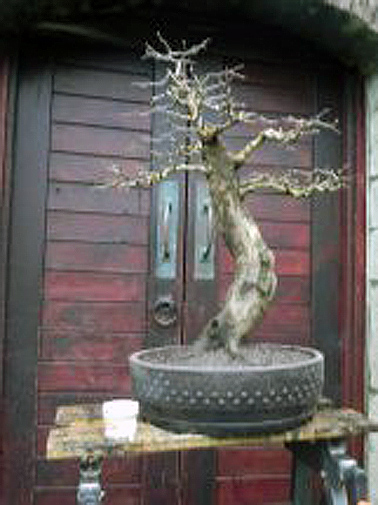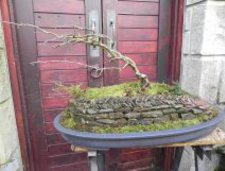
.jpg)
Cornwall Bonsai Society |
SITE PAGES
Hawthorns -
There are 3 hawthorn species commonly seen as bonsai - our native white flowering one, the red 'paul scarlet' variety and the Japanese Hawthorn.
These are a favorite tree of many members and this page will be formed into a Hawthorn care guide based on the experiences of John and Nina with the species.
The first instalment is a little background on two of Johns collected trees. As the season goes on we will cover pruning, feeding and refining the foliage.
Marcus Watts © 2011 • Privacy Policy • Terms of Use
I thought you might be interested in my two recent repots, I had been looking for a while at these two collected Hawthorns, and thinking they would be better if the pots were swopped about, the bent trunk into the round pot and vice versa, so this weekend I got around to doing it.
They are fairly large trees as you can see, (I used the cut paste pot to help with the scale) they were collected from the Bodmin area about 12 or more years ago by machine, the bent trunk tree was last repotted in a 50 -50 mixture of my standard mix and cats litter, and was not doing so well so a repot was definitely in order.

The straight trunk tree I feel is much more suited to the oval pot, I've altered the top and reduced it a lot, and I'm now hoping it will flourish and produce more branches, but it will need time to recover. The bent trunk tree because of the weak soil mix did not develop a good fibrous root system and is now the last of my Cats litter experiments to be repotted into a more suitable soil, certainly the Hawthorns I put in it have not done well.
My two other larger Hawthorns were repotted last year using my standard mix, of Sterilized Top soil ,peat moss, and Cornish grit in equal portions, and both did exceptionally well and won't need repotting this time, we have used this mix for over 30 years and although we have experimented with various soils, still find that for us, it works best for developing native Hawthorn and Blackthorn.
Two more hawthorns,
What I have tried to achieve with the hawthorn on the north Cornish wall, is the sort of scene we see regularly as we drive along, hawthorns that have over many winter storms been bent and knarled by the prevailing wind, The wall is constructed of the soft sedimentary ( killis) found up North, built with broken joints and finished off with a traditional jack and Jill. as opposed to the West Cornwall hedges of granite and built with a totally different technique. I imagine this sort of thing would not be considered strictly Bonsai, but it is good fun to do and gives me a lot of pleasure making, the bottom branch probably needs to come off or be wired into a different position, but I'm open to ideas on that.
The other is in a pot of my making, the tree was formally on a slate,but seemed to lack something, I'm not quite sure if I have it right and may change it back ,but Nina likes the it in the pot, so I'll probably leave it for her.
Regards
John


WIRE. It is very hard to create a convincing bonsai tree without some use of wire. Wiring is essential to steer branches and trunks in the direction you want, to shape the finer foliage and twigs into mature and pleasing shapes, and to pull down branches that rise up in a 'young tree' image. Initially aluminium wire is fine for all your trees, in time you may wish to invest in copper wire for pines and junipers as it does a much better job in the long term